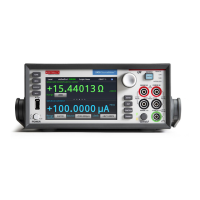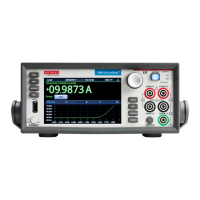Interactive SourceMeter® Instrument Reference Manual Section 2:
2450-901-01 Rev. B/September 2013 2-81
Test fixtures
A test fixture can be used to house a device or test circuit. The test fixture can be a metal or
nonconductive enclosure, and is typically equipped with a lid. When the test fixture is correctly
connected using the interlock, the output of the Model 2450 will turn off when the lid of the test fixture
is opened. Connect the enclosure of all metal test fixtures to protective earth (safety ground). See
your specific test fixture for information. Nonconductive test fixtures must be rated to double the
maximum capability of the test equipment in the system.
You mount the test circuit inside the test fixture.
To provide protection from shock hazards, an enclosure should be provided that surrounds
all live parts.
Nonconductive enclosures must be constructed of materials that are suitably rated for
flammability and the voltage and temperature requirements of the test circuit. Connect the
enclosure of all metal test fixtures to protective earth (safety ground). See your specific test
fixture for information. Nonconductive test fixtures must be rated to double the maximum
capability of the test equipment in the system.
For metallic enclosures, the test fixture chassis must be properly connected to protective
earth (safety ground). A grounding wire (#16 AWG or larger) must be attached securely to
the test fixture at a screw terminal designed for safety grounding. The other end of the
ground wire must be attached to a known protective earth (safety ground).
When hazardous voltages (>30 V RMS, 42 V peak) will be present, the test fixture must meet the
following safety requirements:
• Construction material: A metal test fixture must be connected to a known protective earth
(safety ground) as described in the above warning. A nonconductive test fixture must be
constructed of materials that are suitable for flammability, voltage, and temperature conditions
that may exist in the test circuit. The construction requirements for a nonconductive enclosure are
also described in the warning above.
• Test circuit isolation: With the lid closed, the test fixture must completely surround the test
circuit. A metal test fixture must be electrically isolated from the test circuit. Although the outer
layer on a high voltage triaxial cable must be connected to the test fixture's metal chassis, the
inner two layers of the cable (input/output connectors) must be isolated from the test fixture.
Internally, Teflon standoffs are typically used to insulate the internal printed circuit board or guard
plate for the test circuit from a metal test fixture.
• Interlock switch: The test fixture must have a normally-open interlock switch. The interlock
switch must be installed so that when the lid of the test fixture is opened, the switch will open, and
when the lid is closed, the switch will close.
The Model 2450 includes an interlock connector on the rear panel of the instrument. When
properly connected to a test fixture, the output of the Model 2450 turns off when the lid of the test
fixture is opened.

